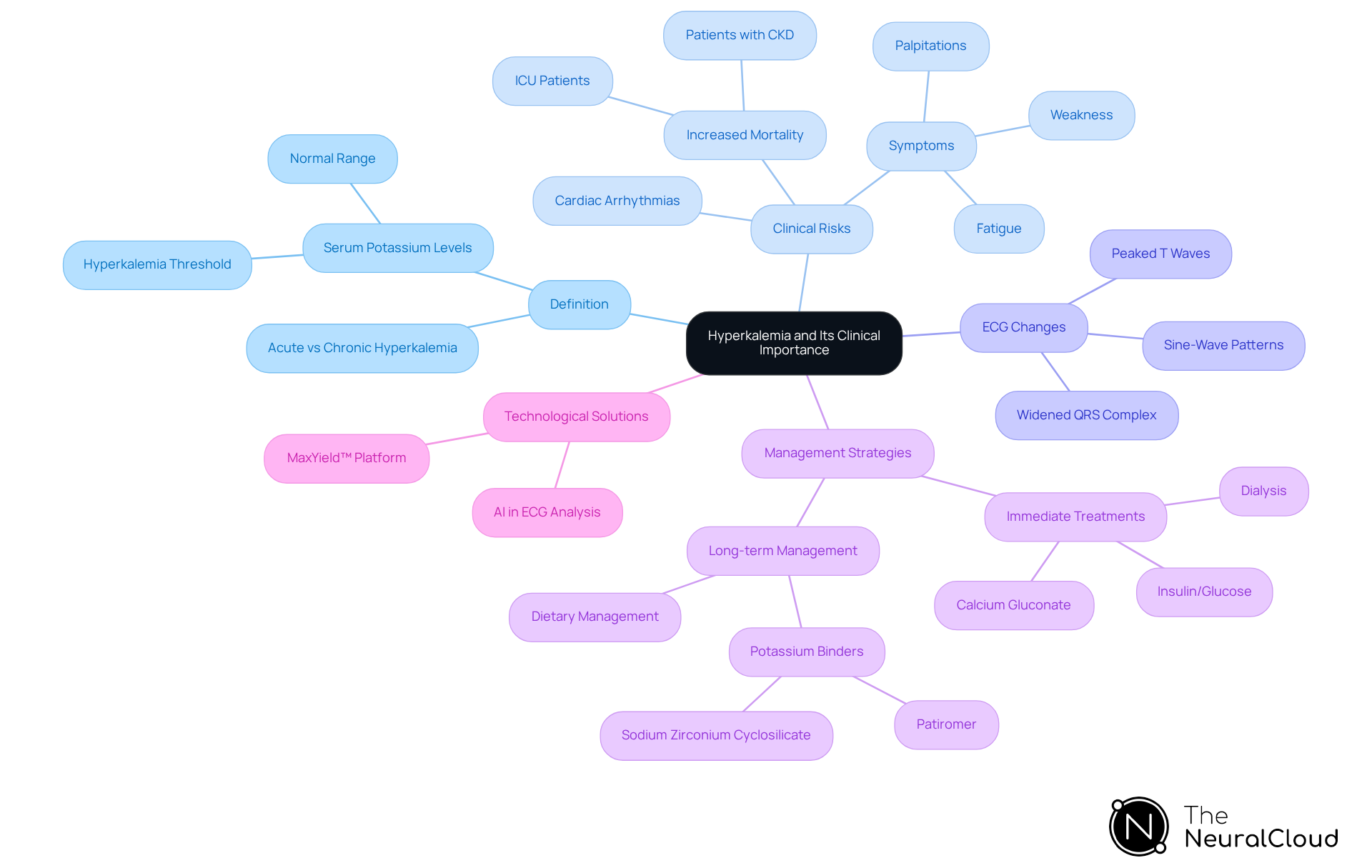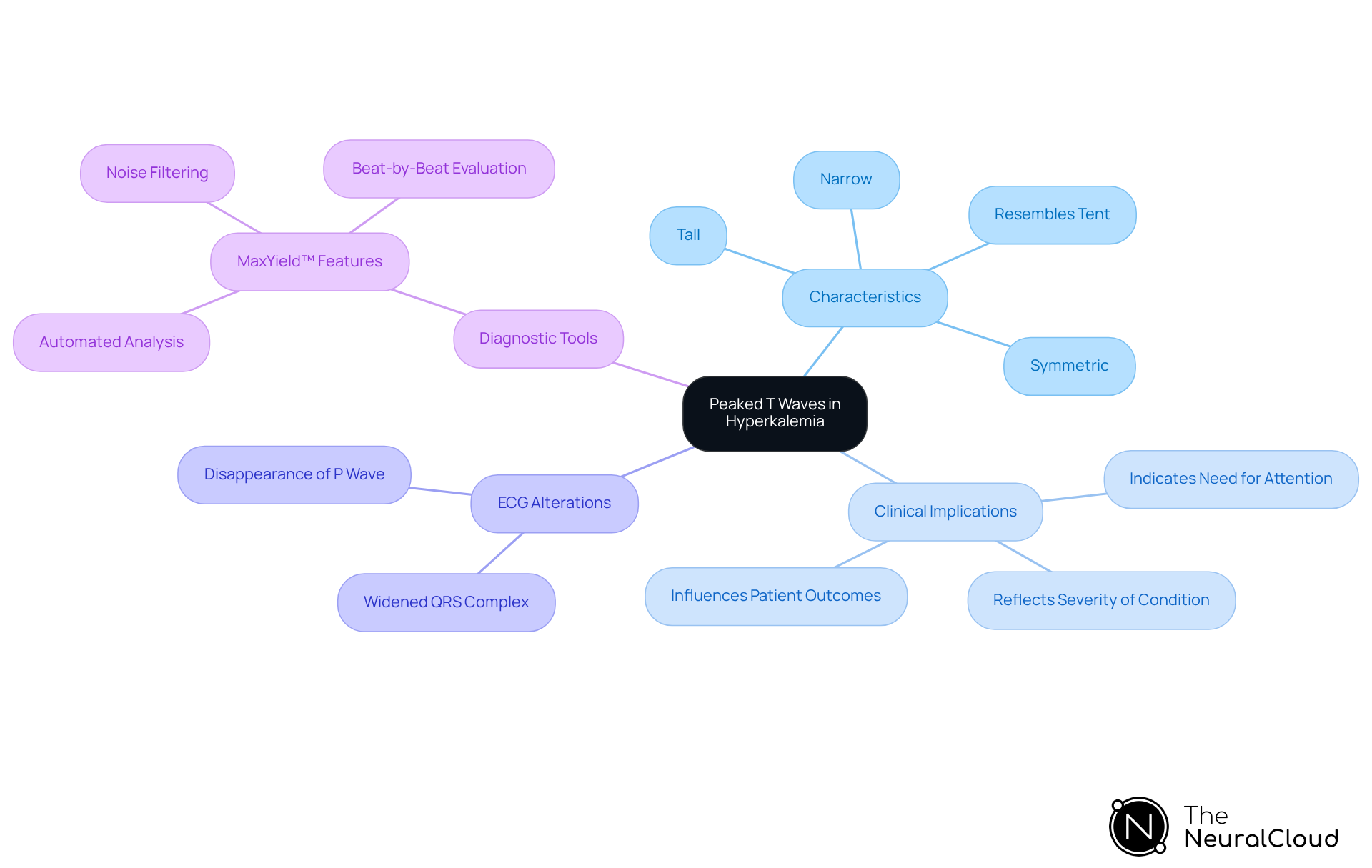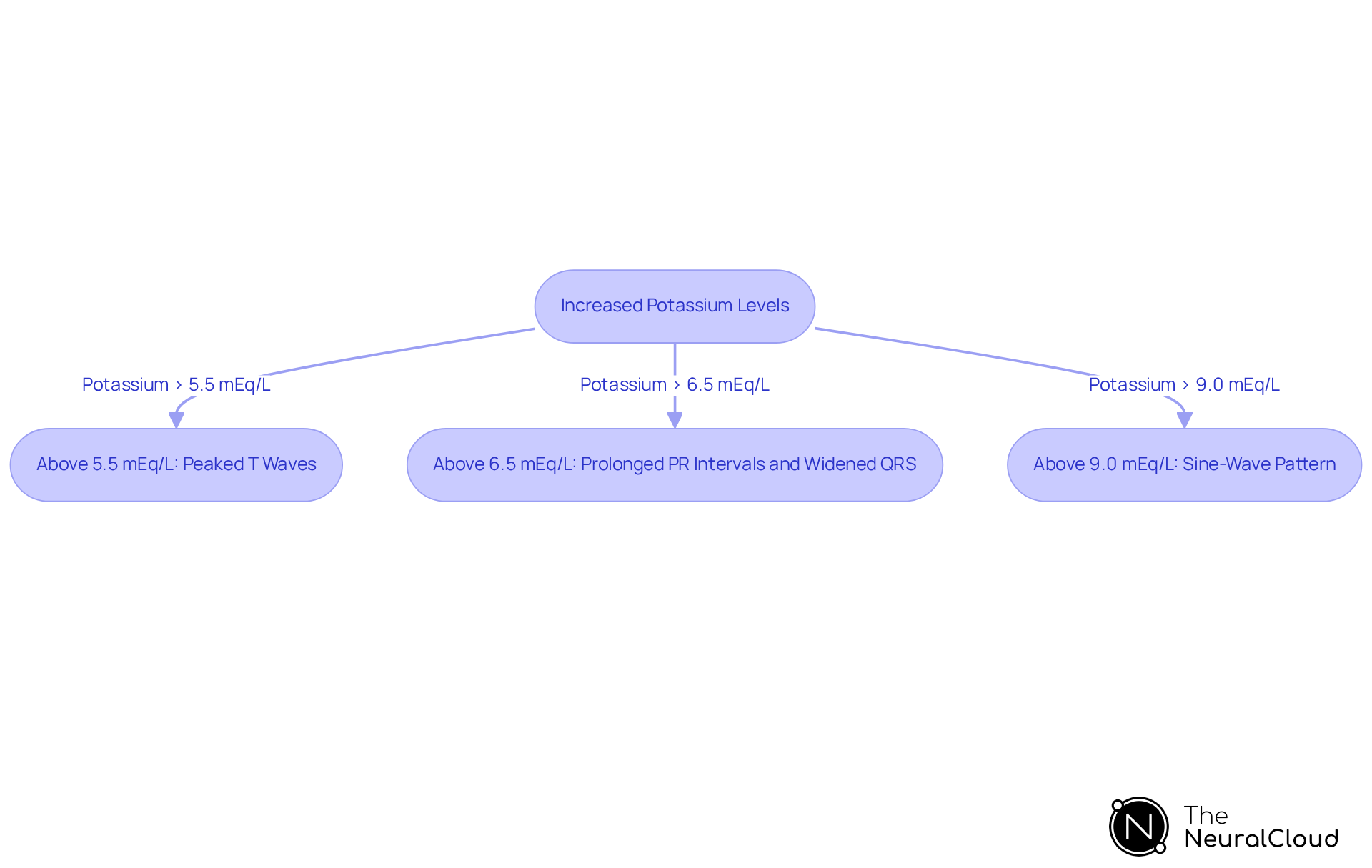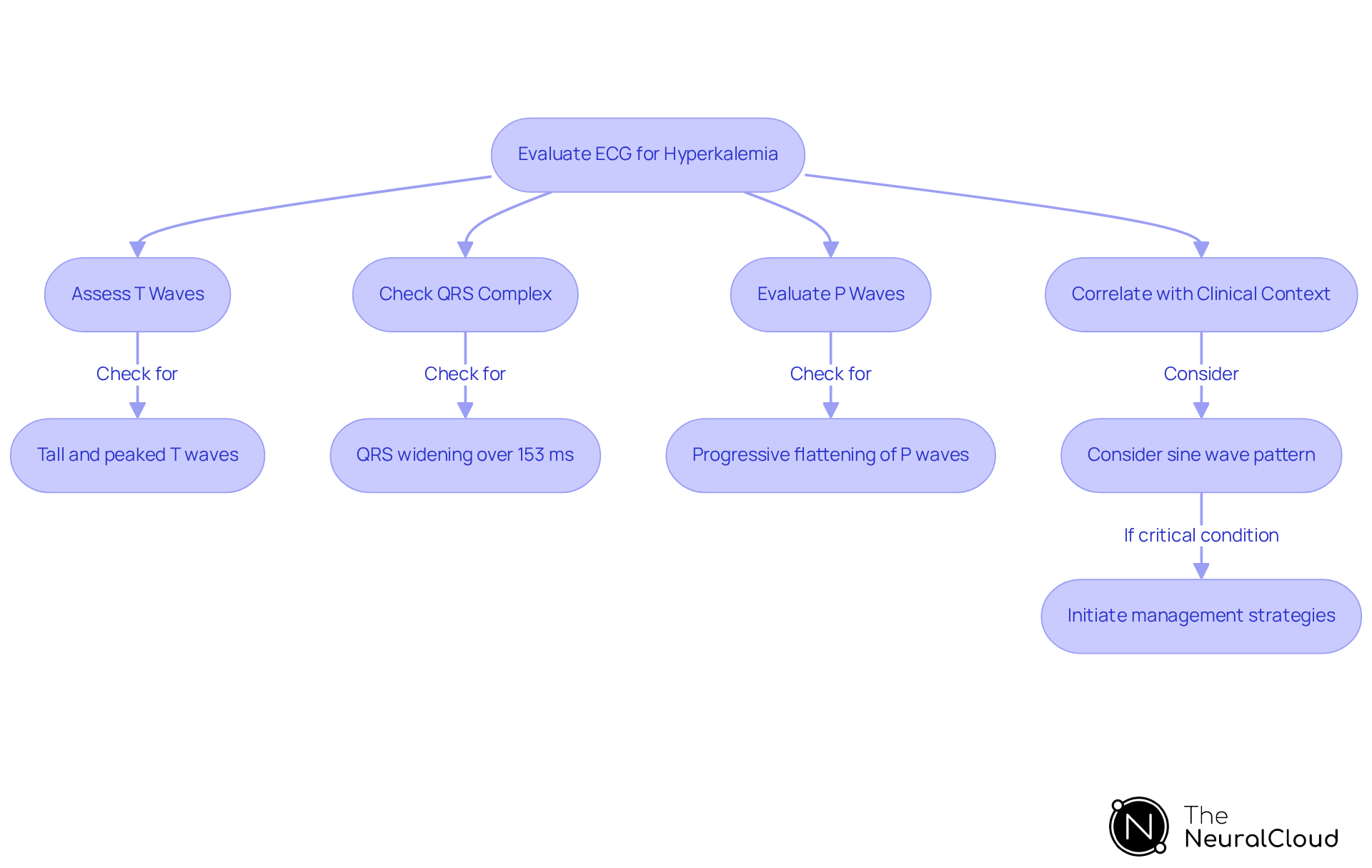Overview
The article provides an overview of hyperkalemia, emphasizing its key ECG changes, particularly peaked T waves, which are critical indicators of elevated potassium levels. These ECG changes, notably the tall, narrow T waves, act as early warning signs of hyperkalemia. The article highlights the importance of timely recognition and intervention to prevent severe cardiac complications. Advanced technologies, such as the MaxYield™ platform, enhance ECG analysis, offering significant improvements in the detection of these critical changes.
The MaxYield™ platform features advanced algorithms that analyze ECG data with high accuracy, allowing healthcare professionals to identify hyperkalemia more effectively. By utilizing real-time data processing, the platform improves the speed of diagnosis, which is crucial in emergency situations. Additionally, its user-friendly interface ensures that both technical and non-technical users can navigate the system with ease.
The advantages of the MaxYield™ platform extend beyond mere data analysis. By providing clear visual representations of ECG changes, it enhances the ability of healthcare professionals to make informed decisions quickly. This capability not only aids in timely intervention but also contributes to better patient outcomes by reducing the risk of severe cardiac complications.
In summary, the MaxYield™ platform stands out as a vital tool in the fight against hyperkalemia. Its innovative features and user-centric design empower healthcare professionals to deliver prompt and accurate care, ultimately benefiting patient safety and health.
Introduction
Hyperkalemia is a condition characterized by elevated potassium levels in the bloodstream, which poses significant risks to cardiac health and can lead to life-threatening arrhythmias. Understanding the critical changes that occur in the electrocardiogram (ECG), particularly the distinctive peaked T waves, is essential for timely diagnosis and intervention.
However, accurately recognizing these ECG alterations amidst other potential cardiac issues presents a challenge for healthcare professionals. Therefore, it is crucial to explore how they can effectively differentiate hyperkalemia's unique ECG signatures to ensure optimal patient outcomes.
Define Hyperkalemia and Its Clinical Importance
Hyperkalemia is characterized by elevated concentrations of potassium in the bloodstream, typically defined as a serum concentration exceeding 5.0 mEq/L. This condition presents significant clinical risks, as it can disrupt normal cardiac function, potentially leading to life-threatening arrhythmias and cardiac arrest. Recent studies indicate that even minor increases in potassium levels can independently predict higher mortality, particularly among severely ill patients. For instance, research involving over 39,000 ICU patients found that potassium concentrations between 4.5 and 5.0 mEq/L were associated with a 49% increased risk of mortality.
The clinical implications of hyperkalemia extend to its effects on ECG analysis. Common ECG changes, such as hyperkalemia peaked T waves, often serve as the initial indicators of rising potassium levels. These alterations can resemble other critical conditions, complicating diagnosis and treatment. Cardiologists stress the importance of early recognition of these ECG patterns, as prompt intervention can significantly enhance patient outcomes. For example, in patients with acute myocardial infarction (AMI), potassium levels above 5.1 mEq/L have been linked to increased mortality rates, underscoring the need for vigilant monitoring.
The 'Neural Cloud Solutions' MaxYield™ platform plays a pivotal role in optimizing ECG analysis in the presence of elevated potassium levels. This platform utilizes and distinct wave recognition to accurately identify and label critical data, even in recordings affected by high noise and artifact levels. This capability is especially valuable in clinical environments where physiological variability and signal artifacts can obscure significant ECG changes. The integration of wearable technology with MaxYield™ further streamlines processes, reduces operational costs, and enables healthcare professionals to concentrate on critical decision-making tasks, ultimately enhancing patient care.
Real-world examples of managing potassium excess reveal the challenges faced in clinical practice. Many individuals with chronic kidney disease (CKD) or those on renin-angiotensin-aldosterone system inhibitors (RAASi) are at an increased risk for elevated potassium levels. Despite the availability of newer potassium binders, such as patiromer, which help optimize RAASi therapy, a significant number of patients discontinue their medications due to concerns over high potassium levels. This discontinuation often leads to worse outcomes, as studies indicate that 74% of patients who stopped mineralocorticoid receptor antagonists (MRAs) due to elevated potassium levels did not resume therapy within a year.
In summary, recognizing the clinical significance of elevated potassium levels is crucial for healthcare professionals. The interplay between elevated potassium levels, ECG changes, and cardiac function necessitates a proactive approach to monitoring and management of conditions like hyperkalemia peaked T waves, particularly in at-risk populations. Leveraging advanced technologies like MaxYield™ can significantly improve the accuracy and efficiency of ECG analysis, ultimately leading to better patient outcomes.

Identify Key ECG Changes: Focus on Peaked T Waves
The hyperkalemia peaked T waves represent one of the most distinctive [ECG changes associated with elevated potassium levels](https://theneuralcloud.com/post/understanding-hyperkalemia-key-ecg-changes-and-peaked-t-waves). They are characterized by their tall, narrow, and symmetric appearance, often resembling a 'tent.' As potassium levels rise, the phenomenon of hyperkalemia peaked T waves may become increasingly pronounced, indicating a critical need for clinical attention.
In severe cases, additional ECG alterations can occur, such as widening of the QRS complex and the potential disappearance of the P wave. Recognizing these changes is vital for healthcare providers, as they reflect the seriousness of elevated potassium levels and underscore the necessity for intervention. Research indicates that hyperkalemia peaked T waves are generally the earliest and most reversible indicators of elevated potassium levels, making their identification essential in acute care settings.
Furthermore, the prevalence of hyperkalemia peaked T waves in cases of elevated potassium levels highlights their significance in clinical diagnostics, as timely recognition can greatly influence patient outcomes. Recent findings suggest that the rapid phase 3 repolarization associated with elevated mineral concentrations leads to these distinctive T wave changes. This emphasizes the need for healthcare practitioners to remain vigilant in observing ECG patterns for .
MaxYield™ enhances the identification of these crucial ECG changes by automating the analysis process. It allows for rapid beat-by-beat evaluation of heartbeats, providing a thorough examination of P-wave, QRS complex, and T-wave onsets and offsets. Healthcare professionals can utilize advanced noise filtering and wave recognition features to isolate and label these essential aspects, even in recordings with significant noise and artifact. By streamlining ECG analysis, MaxYield™ empowers healthcare providers to make informed decisions quickly, ultimately improving patient care.

Explain the Mechanisms Behind ECG Changes in Hyperkalemia
The ECG alterations associated with elevated mineral concentration stem from the significant impact of increased levels on cardiac myocyte depolarization and repolarization. As ion concentrations rise, the resting membrane potential becomes less negative, facilitating depolarization of cardiac cells. This phenomenon primarily accounts for the distinctive T waves that are peaked in hyperkalemia, typically observed when mineral concentrations exceed 5.5 mEq/L. Furthermore, as potassium concentration increases, conduction speed through the myocardium decreases, leading to a widening of the QRS complex. For instance, at concentrations above 6.5 mEq/L, notable ECG changes may occur, such as prolonged PR intervals and atypical QRS shapes. In severe cases, particularly when potassium levels surpass 9.0 mEq/L, the ECG may exhibit a sine-wave pattern, indicating a critical risk of ventricular fibrillation. Understanding these mechanisms is vital for clinicians, as ECG findings can serve as a more reliable predictor of outcomes compared to serum potassium levels alone.
With the integration of MaxYield™, health tech developers can harness advanced to swiftly identify these critical changes, thereby enhancing cardiovascular diagnostics and supporting timely clinical decisions. MaxYield™ offers beat-by-beat analysis, effectively mapping ECG signals through noise, and is compatible with various devices, enabling seamless data capture. This capability allows for prompt and appropriate responses to elevated potassium levels, ultimately improving patient care.

Guide to ECG Interpretation in Hyperkalemia Cases
Interpreting ECGs in suspected hyperkalemia cases requires a systematic approach. Start by evaluating the T waves for formations that are tall and exhibit hyperkalemia peaked T waves, which are early indicators of elevated potassium levels. These T waves typically present a narrow base and rise sharply to form a 'tented' appearance.
Next, assess the QRS complex for widening, a critical sign of worsening hyperkalemia. As potassium levels increase, the QRS duration may surpass 153 milliseconds, signaling a severe condition. Additionally, check for the presence or absence of P waves; their progressive flattening or disappearance suggests significant potassium imbalance and potential atrial arrest, which can lead to bradycardia and AV block.
Always consider the clinical context by correlating ECG findings with the patient's history and lab results. For example, broad QRS complexes combined with tall T waves may create a sine wave pattern, indicating the risk of cardiovascular collapse. To enhance ECG analysis, utilize Neural Cloud Solutions' . This advanced technology automates the labeling and extraction of crucial ECG data, effectively filtering out noise and artifacts. By optimizing the analysis process, MaxYield™ enables clinicians to identify hyperkalemia peaked T waves and other significant changes more clearly.
Finally, act promptly if elevated potassium levels are suspected based on ECG changes. Initiate appropriate management strategies, such as administering calcium gluconate or insulin with glucose, to stabilize cardiac function. Timely intervention is vital, as untreated hyperkalemia can lead to life-threatening conditions like ventricular fibrillation. This structured approach equips clinicians to interpret ECGs effectively and respond to hyperkalemia promptly, ultimately enhancing patient outcomes.

Conclusion
Understanding hyperkalemia and its associated ECG changes, particularly peaked T waves, is crucial for effective clinical management. Elevated potassium levels pose significant risks to cardiac function, making early detection and intervention essential for improving patient outcomes. The intricate relationship between potassium levels and ECG alterations underscores the importance of vigilant monitoring and timely responses in at-risk populations.
Key insights from this exploration include:
- The critical role of peaked T waves as early indicators of hyperkalemia
- The mechanisms behind these ECG changes
- The application of advanced technologies like the MaxYield™ platform to enhance diagnostic accuracy
The ability to recognize and interpret these changes can lead to prompt clinical actions that mitigate the risks of severe complications, such as arrhythmias and cardiac arrest.
In light of the growing prevalence of hyperkalemia, especially among patients with chronic conditions, healthcare professionals are encouraged to prioritize ECG analysis in their monitoring protocols. By adopting a proactive approach and utilizing innovative tools for ECG interpretation, clinicians can significantly improve patient care and outcomes in the face of this potentially life-threatening condition.
Frequently Asked Questions
What is hyperkalemia?
Hyperkalemia is a condition characterized by elevated concentrations of potassium in the bloodstream, typically defined as a serum concentration exceeding 5.0 mEq/L.
Why is hyperkalemia clinically important?
Hyperkalemia is clinically important because it can disrupt normal cardiac function, potentially leading to life-threatening arrhythmias and cardiac arrest. Even minor increases in potassium levels can independently predict higher mortality, especially among severely ill patients.
What are the risks associated with potassium levels between 4.5 and 5.0 mEq/L?
Research indicates that potassium concentrations between 4.5 and 5.0 mEq/L are associated with a 49% increased risk of mortality among ICU patients.
How does hyperkalemia affect ECG analysis?
Hyperkalemia can cause common ECG changes, such as peaked T waves, which often serve as initial indicators of rising potassium levels. These alterations can complicate diagnosis and treatment as they may resemble other critical conditions.
What is the significance of potassium levels above 5.1 mEq/L in patients with acute myocardial infarction (AMI)?
In patients with AMI, potassium levels above 5.1 mEq/L have been linked to increased mortality rates, highlighting the need for vigilant monitoring.
How does the MaxYield™ platform assist in ECG analysis for hyperkalemia?
The MaxYield™ platform optimizes ECG analysis in the presence of elevated potassium levels by utilizing advanced noise filtering and distinct wave recognition to accurately identify and label critical data, even in recordings affected by high noise and artifact levels.
What challenges do patients with chronic kidney disease (CKD) face regarding potassium levels?
Patients with CKD or those on renin-angiotensin-aldosterone system inhibitors (RAASi) are at an increased risk for elevated potassium levels, and many discontinue their medications due to concerns over high potassium levels, leading to worse outcomes.
What percentage of patients who stopped mineralocorticoid receptor antagonists (MRAs) due to elevated potassium levels did not resume therapy within a year?
Studies indicate that 74% of patients who stopped MRAs due to elevated potassium levels did not resume therapy within a year.
What is the overall conclusion regarding the management of hyperkalemia?
Recognizing the clinical significance of elevated potassium levels is crucial for healthcare professionals, and leveraging advanced technologies like MaxYield™ can significantly improve the accuracy and efficiency of ECG analysis, ultimately leading to better patient outcomes.






